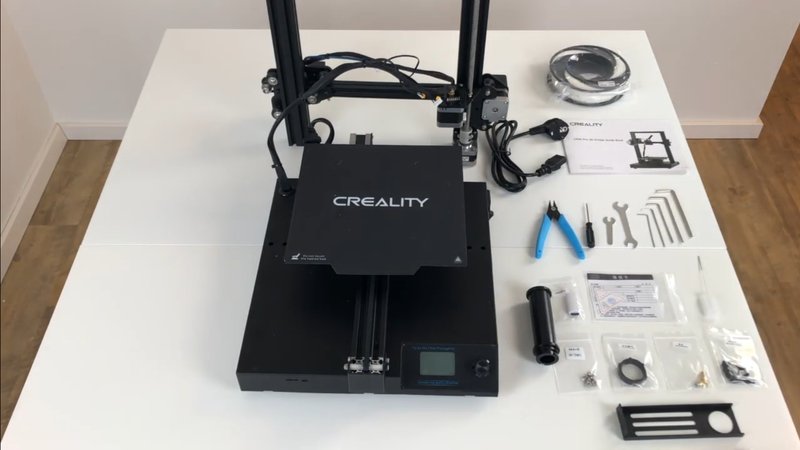
The prices of the FFF/FDM 3D printers have been consistently going down over the last several years. Despite this, useful features and convenient design still usually cost premium. But there are exceptions. The Creality CR-20 is one of those: it’s a low-price machine that is well-built, user-friendly, and offers good quality of printing.

Source: top3dshop.com

Source: creality.com
The CR-20 features the same rail-based modular design of the CR-10 series that offers infinite ways to upgrade and mod the machine. The frame is made of metal and the controls (a monochrome LED screen and the rotary wheel) are now integrated into the base of the machine, as well as the mainboard that is hidden inside. All of this makes the CR-20 look more elegant, modern, and less bulky.
The machine features a heated printing platform. Instead of the glass bed (a popular solution used by a predecessor), the printer now implements a bendable removable one. So now detachment of the prints is going to be much easier.
A Bowden-style short tube allows the printer to work with a variety of filaments.
A power resume option will continue printing after a power failure.
The build volume has been reduced but it’s still not small (220 x 220 x 250 mm). Another feature that is missing but would be nice to have is automatic bed leveling.
The CR-20 comes semi-assembled (a user only needs to work with 6 screws to get everything connected). It’s packaged in a relatively small box.

Source: youtube.com
The contents of the box include: two pre-assembled main frame parts of the printer, some filament, a filament spool holder, cables, some tools (including a screwdriver and a spatula), spare parts, a user manual, warranty, and an SD card.

Source: youtube.com
The machine comes partially assembled, so getting it ready to work is just the matter of connecting all the cables, screws and parts together.
The first step would be to place an upper part of the frame on top of the base.

Source: youtube.com
Align the top parts with the holes on the side of the printer.

Source: youtube.com
Then take the screws that come with the printer, turn the machine upside down and tighten four screws.

Source: youtube.com
Now connect the cables. They are labeled so you shouldn’t have a problem with getting them wrong.

Source: youtube.com
Lock the motor and endstop connectors.

Source: youtube.com
Place the spool holder on top of the printer. It’s held in place by two screws.

Source: youtube.com
The printer is now ready to do its job.
Connect the power cable and turn on the CR-20.

Source: youtube.com
Tighten the extruder carriage connection if it wobbles.

Source: youtube.com
Now let’s calibrate the bed.
Select the ‘Auto home’ in the main menu.

Source: youtube.com
Place a piece of paper between the nozzle and the bed.

Source: youtube.com
Rotate the nut until the paper is only slightly touching the nozzle.

Source: youtube.com
Repeat the process for all of the corners.

Source: youtube.com
Now the bed is properly leveled.
The next step would be to find ‘Preheat PLA’ in the menu and select it.

Source: youtube.com
Insert the PLA filament.

Source: youtube.com
Insert the SD card and select the file from the menu.

Source: youtube.com
Now the machine will print its first work.
The machine is compatible with Cura (as well as its fork called Creality Slicer), Repetier-Host, and Simplify3D.
This prototype shows how functional the models printed on the CR-20 can be.

Source: instagram.com
Based on the design found on Thingiverse, this phone stand is a relatively simple print that nevertheless can show the impressive surface finish of the CR-20’s prints. This is a very useful and good-looking model.

Source: instagram.com
This Instagram user wanted to build his own lightsaber. He printed the three components separately. Despite the 3D printing characteristic layered texture, they look really nice.

Source: instagram.com

Source: instagram.com
Printed with at a layer height of 0.2 mm, this medieval castle showcases how detailed and high-quality the prints done with the Creality CR-20 can be.

Source: instagram.com

Source: instagram.com
Look how smooth the model turned out to be!

Source: instagram.com
Pros
Cons
The Creality CR-20 is a continuation of Creality’s tradition to produce a simplistic and low-price FFF/FDM machine. The design is sleek and more functional than before, but the build volume — a selling point of the CR-10 line — was reduced. The sturdy all-metal frame makes up for that. It also allows to work various filaments and significantly reduces the noise levels. Not to mention, that it looks better and more professional.
The shortcomings include the lack of assisted calibration and touchscreen. Some users won’t be happy with the change of the print plate type — from the glass plate to a flexible bed, but it’s a matter of preference.
Overall, the CR-20 is a budget machine that is easy to work with, offers enough functionality, is well-built, and produces prints of rather good quality.
Update your browser to view this website correctly. Update my browser now
Write a comment